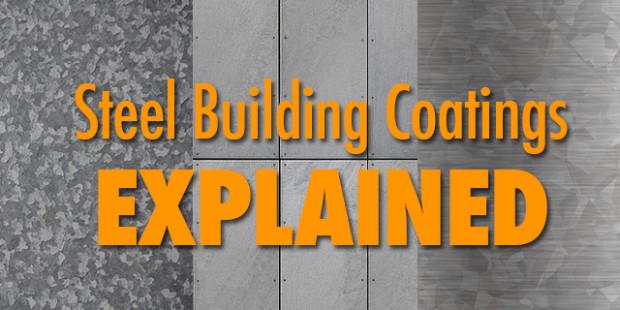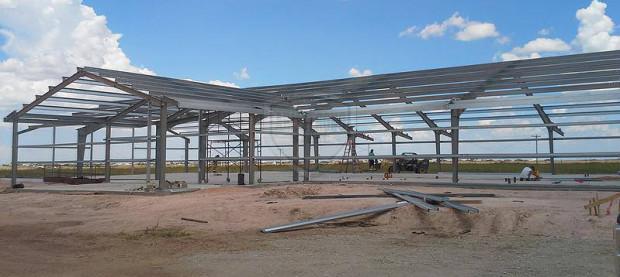Steel Building Coatings Explained

Steel buildings are some of the most flexible, durable building solutions on the market today. Thousands of people choose to build with steel every day because of its strength, energy efficiency, and cost savings. When it comes to your current or future steel building, it’s important to make sure it’s properly protected.
Why Your Steel Building Needs a Protective Coating
Steel itself is made up of alloys of mostly two elements: iron and carbon. Zinc can also be found in steel. Zinc helps enhance the performance and longevity of steel. While made of strong and durable elements, steel is prone to rust, corrosion, and sun damage in almost every environment. Rust is an even greater concern for steel buildings that are exposed to harsh conditions. A protective coating will help prevent your steel building from rusting. It’s also important to consider your compliance regulations, most building structures require protective coatings.
Types of Steel Building Coatings
Prefabricated steel buildings can be protected by a few different types of coatings and paint. Each type works in different ways to keep your steel structure from accumulating rust.
Galvanized Steel
Galvanization is the process of applying for that protection from corrosion. When a piece of steel is galvanized, usually by hot-dip galvanization, it forms a coating of rust-resistant zinc. The coating thwarts destructive substances from reaching the metal. Even if the steel is scraped or scratched the armor created by the galvanization process will protect it.
When shopping for steel buildings, ensure that the secondary framing, base angle, and flange bracing are pre-galvanized to prevent rust.
There is also a weight and thickness designation for galvanization. The industry standard is G-30. For instance, a G-60 coating has twice the thickness of a G-30 coating, and therefore its life is twice as long. However, Armstrong’s pre-galvanization is G-90, three times the amount of the industry standard, three times as thick, and three times as long-lasting. This is extremely important for the steel in your entire building, but it’s crucial for the smaller parts, like your base angle, which is only about as thick as a dinner plate.
Galvalume®
Galvalume® is an alloy with a mixture of zinc and aluminum. Zinc is something of a “healer” to the steel in this situation. Steel is dipped into a coating of 55% aluminum, 43.4% zinc, and 1.6% silicone. This unique coating provides greater protection from the elements, which allows it to outlast traditional galvanized steel.
Red Oxide Primer
You may have seen some steel building rigid frames, with a reddish color. These rigid frames are covered in red oxide primer. This type of coating is an exterior and interior rust-preventative solvent-based metal primer for steel. Red oxide primer is a base-coat paint that is specifically for use on the surface of iron and steel as a top coat. However, red oxide primers are red for a reason. The red color naturally hides any signs of rust. This can make it harder to see and resolve any rust issues your building may be having.
Zinc Rich Primer
Zinc-rich primers can also be used to protect steel structures from rust and corrosion. The zinc-rich primer creates a moisture-blocking seal that can last 30 years in a rural environment and 15 years in a seacoast or heavy industrial environment. The primer must be in direct contact with the steel in order to work properly. Once your steel building is primed with zinc, you can choose any color of exterior paint you’d like.
Silicone Modified Polyester Paints
Silicone polyester paint (SMP) should minimize chalking and fading by resisting the detrimental effects of the sun’s UV rays, rain, humidity, and
weathering. Some paints contain basic polyester, which provides good color retention, exterior durability, and abrasion resistance to the sun, rain, and other adverse weather conditions. For instance, the paint on Armstrong’s sidewall panels carries a 40-year warranty against chipping, cracking, peeling, or blistering. You can choose from 20 different colors, selecting a different color for your walls, roof, trim, and wainscoting if you’d like. For improved protection, consider galvanizing or using a zinc-rich primer before applying silicone polyester paint.
Budget
Your budget will play one of the largest roles in determining which steel protective coating is right for you. There is value in selecting a quality protectant that can prevent future damage that can be more expensive to repair. Less expensive is not always the best choice.
Aesthetics
Consider how you would like your steel structure to look. Do you want to preserve the natural look of the steel? Are you wanting to match this new steel structure to another building on the property?
Intended Building Lifespan
How long do you intend to use your steel building? Your protective coating should be one that matches or outlasts the building’s intended lifespan of use.
Talk to your steel building expert about what coatings are available for your steel building. As with any project, you want it done right the first time, and you want it to last. Different steel building protective coatings will go a long way to making sure it does. Learn more about steel buildings with Armstrong Steel. 
Photo courtesy: Filter Forge, Andrew Beeston, Seier+seier
« 4 Ways a Metal Building Will Help Your Company Retain Profits
Should a Used Steel Building Scare You? »
Popular Posts

To get off the ground, a lot of small businesses enter the marketplace with a ton of debt. There are operation fees, salaries to pay and product costs to account for. Getting rid of that debt can be extremely difficult, but dumping business liability is a lot like getting rid of personal debt. Really, the… …

Remember the old Burger King slogan, “Have it your way?” While I might have some pretty awesome grill skills, I’m not talking about burgers here. If you think you might be interested in a metal building, you truly have a lot of options when it comes to the exterior design of your structure. You can… …

